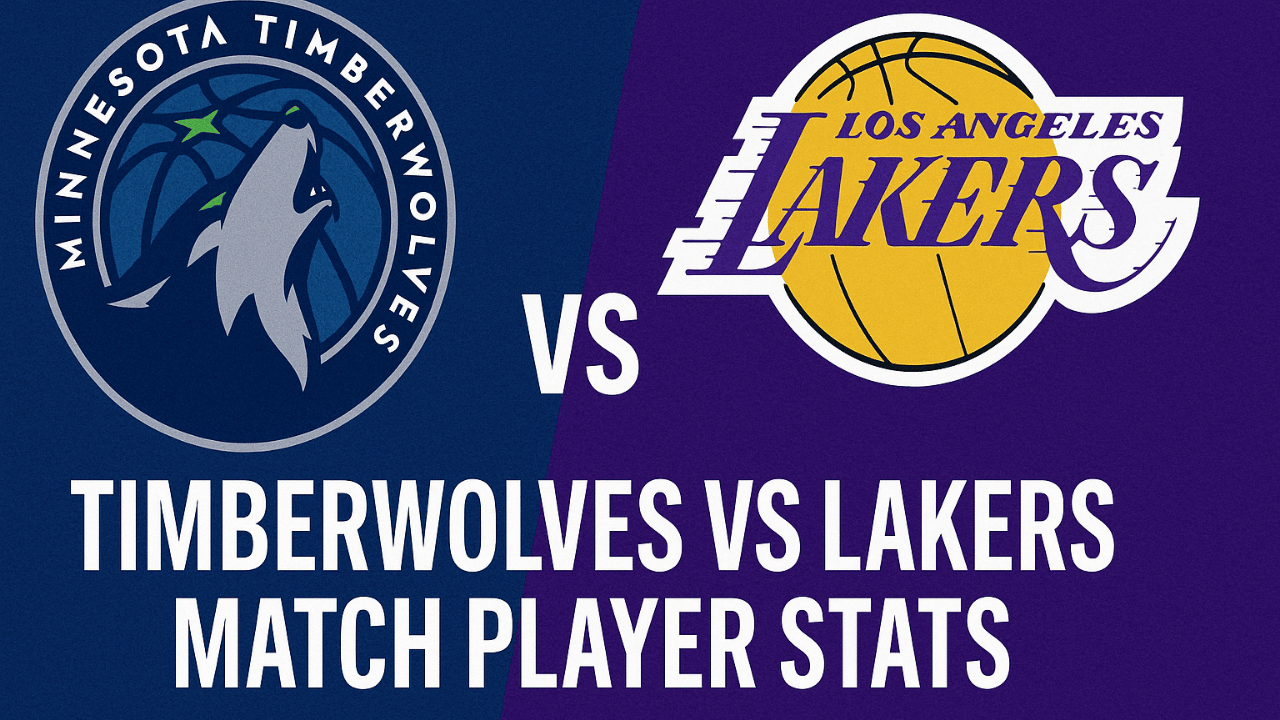The recent series between Minnesota Timberwolves and Los Angeles Lakers brought out a rollercoaster of emotions for basketball fans, analysts, and players alike. With both teams stacked with all-star caliber talent and rising youth, this series promised intensity and delivered unforgettable moments. This article provides a full breakdown of the timberwolves vs lakers match player stats, giving readers a clear view of how the series unfolded, who stood out, and what ultimately made the difference.
1. Game 1 Player Performances Set the Stage
The opening game of the series saw the Timberwolves fall short despite some impressive individual showings. Jaden McDaniels stepped up big with 25 points and 9 rebounds, hitting 11 of his 13 shots. Anthony Edwards contributed 22 points, 8 rebounds, and 9 assists, but struggled with efficiency, shooting just 8-of-22.
Naz Reid’s impact off the bench cannot be overlooked as he poured in 23 points, including 6-of-9 from beyond the arc. His long-range shooting helped the Timberwolves remain competitive.
On the Lakers’ side, Luka Dončić showcased why he’s one of the league’s premier talents, scoring 37 points with 8 rebounds on 12-of-22 shooting. LeBron James played a supporting role with 19 points and 3 blocks, leading his team to a convincing Game 1 win.
These timberwolves vs lakers match player stats from Game 1 already showed what fans could expect: a series fueled by star power, but dependent on consistency and depth.
2. Timberwolves’ Turnaround in Game 3
After a tough Game 1, the Timberwolves responded with fire in Game 3. Jaden McDaniels led the scoring with a career-playoff-high of 30 points, supported by 5 rebounds. Anthony Edwards was nearly flawless in decision-making, recording 29 points, 8 rebounds, and 8 assists. He was instrumental in the closing moments, leading a 13–1 run to seal the game.
LeBron James did all he could to keep the Lakers in contention, finishing with 38 points on 13-of-21 shooting. Despite his efforts, the Lakers were unable to counter Minnesota’s balanced attack.
In the context of timberwolves vs lakers match player stats, Game 3 highlighted Minnesota’s resilience and ability to adjust defensively while maintaining offensive flow.
3. Dominance on the Boards in Game 5
Arguably the turning point of the series came in Game 5 when Rudy Gobert delivered a historic performance. The center dominated the paint with 27 points and an astonishing 24 rebounds—setting a franchise playoff record. His presence on both ends of the floor altered the game’s momentum and kept second-chance points heavily in Minnesota’s favor.
Julius Randle chipped in with a solid 23-point performance, maintaining consistent scoring throughout the game. Meanwhile, Luka Dončić registered 28 points, 7 rebounds, and 9 assists but was visibly slowed down by a back issue.
LeBron contributed 22 points, but the lack of size and rim protection became glaring issues for the Lakers. This matchup tilted heavily in favor of Minnesota due to rebounding and interior defense, reflected clearly in the timberwolves vs lakers match player stats.
4. Fourth Quarter Mastery from Minnesota
One of the most decisive trends across the series was Minnesota’s control in the fourth quarter. Over the span of the series, they outscored the Lakers 127–85 in final quarters. This consistency in closing out games made the difference, especially in closely contested matchups.
Anthony Edwards emerged as the go-to closer, often orchestrating late-game possessions with maturity beyond his years. The bench also came alive during crunch time, providing energy and momentum shifts that helped secure wins.
Looking through the lens of timberwolves vs lakers match player stats, fourth-quarter execution becomes a central storyline that cannot be ignored.
5. Bench Impact and Role Players’ Rise
While stars like Edwards and Dončić grabbed headlines, the bench performances throughout the series were just as critical. Naz Reid’s Game 1 explosion from three-point range and Julius Randle’s consistent double-digit scoring across multiple games added depth to Minnesota’s attack.
The Lakers, on the other hand, struggled with their bench production. The lack of a backup center and limited scoring options hurt them when the starters rested. As a result, Minnesota’s depth created separation over time.
From a statistical perspective, these timberwolves vs lakers match player stats demonstrate that playoff success relies not only on top-tier talent but also on the effectiveness of secondary units.
6. Strategic Impacts and Roster Decisions
A big talking point surrounding the Lakers was their roster construction, particularly the trade of Anthony Davis for Luka Dončić. While Dončić undoubtedly delivered elite performances, the absence of a true defensive anchor in the paint left the team vulnerable.
Minnesota exploited this mismatch by feeding Gobert and Randle inside, winning the rebounding battles and points in the paint. The timberwolves vs lakers match player stats show a consistent advantage for Minnesota in these categories, underscoring the consequences of that roster decision.
J.J. Redick’s coaching adjustments were notable but limited by the tools at his disposal. In contrast, Chris Finch effectively managed rotations and matchups, especially against the Lakers’ weaker defensive links.
7. Fans and Media Reactions
Social media and sports talk were buzzing with praise for Minnesota’s disciplined approach and the development of their young core. Anthony Edwards, in particular, received high acclaim for his leadership, poise, and ability to deliver in high-pressure situations.
LeBron James, despite his age, earned respect for his continued high-level play. However, much of the discussion focused on the Lakers’ lack of interior defense and how it cost them dearly.
Across forums and broadcasts, conversations kept circling back to the timberwolves vs lakers match player stats, which laid bare the contrast in depth, defense, and execution.
8. Series Statistics at a Glance
To summarize some critical series-wide stats:
- Anthony Edwards averaged 26.7 points, 7.5 rebounds, and 7.1 assists per game.
- Rudy Gobert averaged 14.5 points and 17.3 rebounds per game.
- Luka Dončić posted series averages of 31.4 points, 8 rebounds, and 8.5 assists.
- LeBron James contributed 25.1 points, 6 rebounds, and 4.8 assists per game.
- Timberwolves outrebounded the Lakers by an average of +11 per game.
These timberwolves vs lakers match player stats reveal the superior balance and physicality Minnesota brought to the series.
Conclusion
The timberwolves vs lakers match player stats provide a clear window into why Minnesota emerged victorious in this playoff battle. From Anthony Edwards’ clutch performances to Rudy Gobert’s historic rebounding efforts, the Timberwolves proved they are a team with both youth and experience to compete at the highest level.
The Lakers, despite the brilliance of Dončić and LeBron, fell short due to gaps in roster depth and size. The outcome of the series wasn’t decided by one game or moment—it was the cumulative result of strategic execution, bench impact, and fourth-quarter dominance.
As the postseason continues, the spotlight remains on Minnesota’s ability to carry this momentum forward. Fans and analysts alike will continue to dissect the timberwolves vs lakers match player stats for insights, lessons, and expectations for the future.

